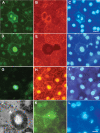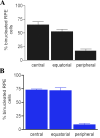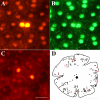Mature retinal pigment epithelium cells are retained in the cell cycle and proliferate in vivo
- PMID: 18843376
- PMCID: PMC2562424
Mature retinal pigment epithelium cells are retained in the cell cycle and proliferate in vivo
Abstract
Purpose: To investigate the capacity of mature retinal pigment epithelium (RPE) cells to enter the cell cycle in vivo using a range of RPE-specific and proliferative specific markers in both pigmented and albino rats.
Methods: Whole-mounted retinas of both Dark Agouti and albino rats were immunolabeled with cell cycle markers Ki67 or PCNA and double labeled with RPE cell marker RPE65 or CRALBP. The number and distribution of these cells was mapped. An additional group of Dark Agouti rats were given repeated intraperitoneal injections of Bromodeoxyuridine (BrdU )for 20 days and then sacrificed 30 days later. The retinas were then processed for BrdU detection and Otx, a RPE cell-specific marker. For comparison, human RPE tissue from a postmortem donor was also labeled for Ki67.
Results: In both pigmentation phenotypes, a subpopulation of mature RPE cells in the periphery were positive for both cell cycle markers. These cells were negative for Caspase 3, hence were not apoptotic. Ki67-positive cells were also seen in human RPE. Further, many cells positive for BrdU were identified in similar retinal regions, confirming that RPE cells not only enter the cell cycle but also divide, albeit at a slow cell cycle rate. There was a ten fold increase in the number of RPE cells positive for cell cycle markers in albino (approximately 200 cells) compared to pigmented rats (approximately 20 cells).
Conclusions: Peripheral RPE cells in rats have the capacity to enter the cell cycle and complete cellular division.
Figures








References
-
- Curcio CA, Sloan KR, Kalina RE, Hendrickson AE. Human photoreceptor topography. J Comp Neurol. 1990;292:497–523. - PubMed
-
- Cunea A, Jeffery G. The ageing photoreceptor. Vis Neurosci. 2007;24:151–5. - PubMed
-
- Gao H, Hollyfield JG. Aging of the human retina. Differential loss of neurons and retinal pigment epithelial cells. Invest Ophthalmol Vis Sci. 1992;33:1–17. - PubMed
-
- Balazsi AG, Rootman J, Drance SM, Schulzer M, Douglas GR. The effect of age on the nerve fiber population of the human optic nerve. Am J Ophthalmol. 1984;97:760–6. - PubMed
-
- Panda-Jonas S, Jonas JB, Jakobczyk-Zmija M. Retinal pigment epithelial cell count, distribution, and correlations in normal human eyes. Am J Ophthalmol. 1996;121:181–9. - PubMed
Publication types
MeSH terms
Substances
Grants and funding
LinkOut - more resources
Full Text Sources
Other Literature Sources
Research Materials
Miscellaneous
